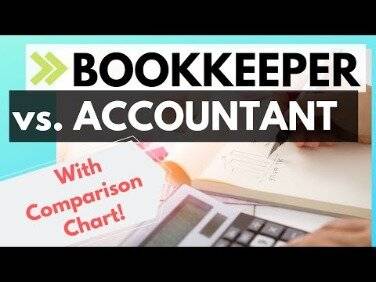
This typically comes at the end of the financial year, when clients’ books need to be “closed” for tax season. Your bookkeeper may not be able to devote as much attention to your business during this time of year as they normally would. Robert Half recruiters look for bookkeeping candidates who are self-starters with solid communication, organizational and customer service skills.
- For a small business with relatively straightforward finances, it’s generally more affordable than either a freelancer or a firm.
- With so many responsibilities on your plate, you might be wondering if hiring a professional bookkeeper is the right choice for you.
- Whether that’s payroll for your staff, collecting rent, paying utilities, taking care of invoices, or running monthly financial statements, a lot goes into property accounting.
- These professionals stay updated on accounting regulations and standards.
- The cost for a bookkeeper will change dramatically based on a number of factors, including location, experience, education, and employment status.
Just ensure that before looking at candidates you understand your own requirements. Once you do, you can then work on identifying people for the role. payroll accounting setting up and calculating staff payrolls A bookkeeper isn’t expected to have a four-year accounting college degree. However, they must have the ability to work accurately and quickly.
Why Every Small Business Should Hire a Bookkeeper
A good bookkeeper can save you time, provide useful business reports, share insights and alert you to red flags, and help you manage your cash flow. You should consider your business’ needs, transaction volume and budget before you hire a bookkeeper. A bookkeeper can make it easier to do your taxes and give you more time to run your business — but they can cost more and take time to get used to. You may have to worry about transferring all your data on top of learning a new way of bookkeeping. It’s easier to transfer data to more modern platforms like Xero than it is others (looking at you, QuickBooks Desktop). If your business is fresh and you only have a handful of transactions each month, you’re likely better off saving the money and doing your bookkeeping on your own.

Now that you know what to look for in outsourced bookkeeping services, start searching today! Don’t sacrifice quality, be diligent in your vetting, and find the right bookkeeper for your company so you can keep growing your business. Some cities and states have begun enacting pay transparency laws where companies must list a target salary or a salary range in the public job ad.
What are the top benefits of hiring a bookkeeper?
Financial accountants calculate assets and liabilities and show outside investors how a firm is doing. Cost accountants analyze financial processes within an organization and makes recommendations for improved cost control management. Ultimately, a bookkeeper can bring peace of mind, expertise, and time savings, allowing you to focus on what truly matters – growing your business. Carefully weigh the pros and cons, and make a decision that best aligns with your business goals and resources.
Consider administering a practical bookkeeping test or assessment to evaluate their technical skills and problem-solving abilities. The CPB is certified by the National Association of Certified Public Bookkeepers (NACPB) and is the more accessible of the two certs. Bookkeeping certifications are totally optional, unlike accounting, where a CPA designation is mandatory. As you continue working with them, a flat rate may become feasible, and offer the benefit of a predictable bookkeeping expense in your monthly budget.
Get the best out of your business
If you find a team of trusted bookkeepers or an outsourced network of them, make sure they have quality hiring standards and are able to take on the workload that your company needs. Whether you’re hiring remotely or within your area, someone working in Boston is bound to charge more than somebody in Omaha. They save you time by handling all the daily financial work for you and allow you to concentrate on the running of your business. The real-time information they collect can help them offer you new insight into your business. It’s best if you can find someone who uses the same accounting software as your accountant.
Although these are fairly wide ranges, they can be narrowed down based on your industry, the experience of the bookkeeper, the nuances of your business, and your company location. For example, if you run a restaurant where employees routinely have tips, minimum wage is frequently an issue. You’ll likely want a bookkeeper that’s worked in the same industry. So, make sure your job description is clear about the job history and experience you need. While bookkeepers have no licensing requirements like a CPA, voluntary organizations can certify applicants.
You only prepare your books ahead of tax season
With their expertise in handling day-to-day finances, bookkeepers can free up your time to concentrate on essential aspects of business growth. Post the job opening on reputable job boards, professional networking platforms, and your company’s website. Finally, if you have a larger business with a lot of financial work to be done, you may want to hire a full-time bookkeeper to your team. Freelance bookkeepers often work remotely and manage the books for several clients, so they are happy to work part-time or as needed for your business. By hiring a bookkeeper you’ll know where your company stands financially.
What makes a bookkeeper worth hiring?
Real-time information is also vital if you want to make sound business decisions. Trusting the financial details of your business with anyone is a big step. There are many bookkeeping businesses, so you’ll have plenty of choice. You could contact one directly, or you could ask if your business partners or clients have any recommendations. If your prospective bookkeeper does, you should consider what you’d do if they’re sick or call out for other reasons—have a backup plan in case your bookkeeper is out of office.
Small Business Trends is an award-winning online publication for small business owners, entrepreneurs and the people who interact with them. Our mission is to bring you “Small business success … delivered daily.” You can use either the virtual option or a professional service to get timely insights and quick responses to urgent matters. Bookkeeping companies invest in industry-leading accounting tools and software. A bookkeeper can weave all of those financial needs and others together. This blog will walk you through why every small business needs one.
Ask about their familiarity with accounting software, understanding of financial statements, and ability to handle specific bookkeeping tasks. Inquire about their experience with industry-specific regulations or any relevant certifications they hold. Additionally, assess their problem-solving abilities and communication skills. Then, accountants can provide analysis and guidance based on those financial records. You should consider hiring a bookkeeper when you need ongoing support in these areas to ensure that your financial records are up-to-date and accurate.
